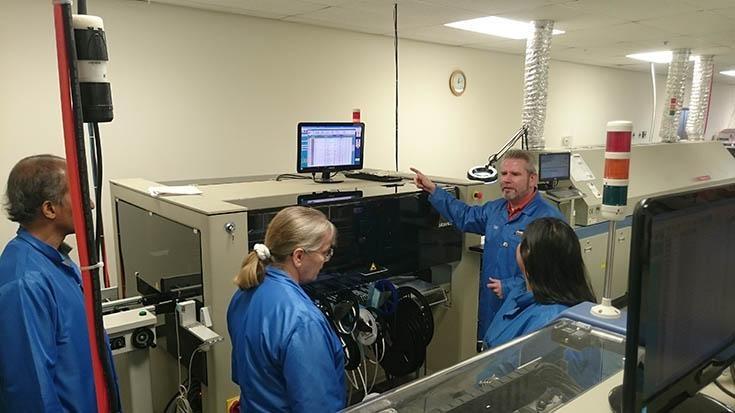Re-Shoring, It Just Makes Sense...
Recently, two Bucks County companies took advantage of a Pennsylvania grant providing training money and assisting in the companies’ efforts to bring back work lost to off shore competition. After receiving the matching grant award, we talked to Tom Krol, IMET Corporation and Aidan Campbell, O.P. Schuman & Sons, Inc. about their views on re-shoring strategies and any suggestions that might have for other companies looking to implement a re-shoring strategy of their own.
Gentlemen, the first question we would like your help with is: our company is committed to re-shoring because ...

Machine optimization training at IMET has increased throughput by over 20%.
AIDAN: It just makes sense! Why send your company’s work to a place you cannot easily keep an eye on it? Would you just close the door to your own shop and not watch what your employees are doing?
TOM: As an assembler of printed circuit boards, we rely on highly automated tools and a skilled workforce. We are committed to using that advantage to re-shore work and create even more jobs.
How does the money from a grant like this one help you implement your re-shoring strategy?
AIDAN: For small businesses, chasing work is very expensive and the upfront capital requirements demand a serious commitment with no guarantee of return. Having financial help bridges some of those commitment burdens.
TOM: The grant money really helps our re-shoring efforts. We are bringing back lighting work from Mexico, in part due to money received for incumbent worker training on existing machine optimization and training on a new PCB de-panel machine. Machine optimization training on the new equipment has increased throughput by over 20% and reduced manual labor on the de-paneling step by over 70%. This is just our own example of how process improvement and better labor utilization makes local manufacturing more competitive again.
What guidance would you offer another company looking to implement a re-shoring strategy?
AIDAN: Look at the true Total Cost of Ownership. Just because you can buy a widget for 30% less from somewhere else does not mean you are saving 30% on the cost of that part. The hidden costs of long distance travel, significantly more communication, unaccounted for time from quality and re-work issues are just a few items that narrow the delta between perceived cost savings and actual money out of pocket. When you keep the work here, a simple phone call or just a short drive is all that it takes to keep you up and running and to work out any issues that may arise. The close relationships you have with your local manufacturers many times more than off sets the perceived savings from going off shore.
TOM: The US companies that persist in going off shore need to understand the model of modern local manufacturers. Manual labor is thing of the past. Wide spread use of advanced technology and skilled workforces is the rule not the exception in our region. We have to remain committed to educating OEM’s that the stigma of old school manufacturing is history. If you are being threatened by the loss of business to off shore operations, educate yourself on the TCO (Total Cost of Ownership) tool. Then provide your customer with a knowledgeable, fact driven presentation of just how much better they will do by staying right here with their supplier.
Guidance with the use of this and other related tools is available through BCEDC, DVIRC and the Manufacturers Alliance of Bucks and Montgomery Counties.
To learn more about SEWN, please visit www.steelvalley.org or contact Greg Olson, SE Regional Director, 215-458-7580, sewnse@steelvalley.org.

